BEYOND THE WALL https://bloximages.chicago2.vip.t
Post# of 65629

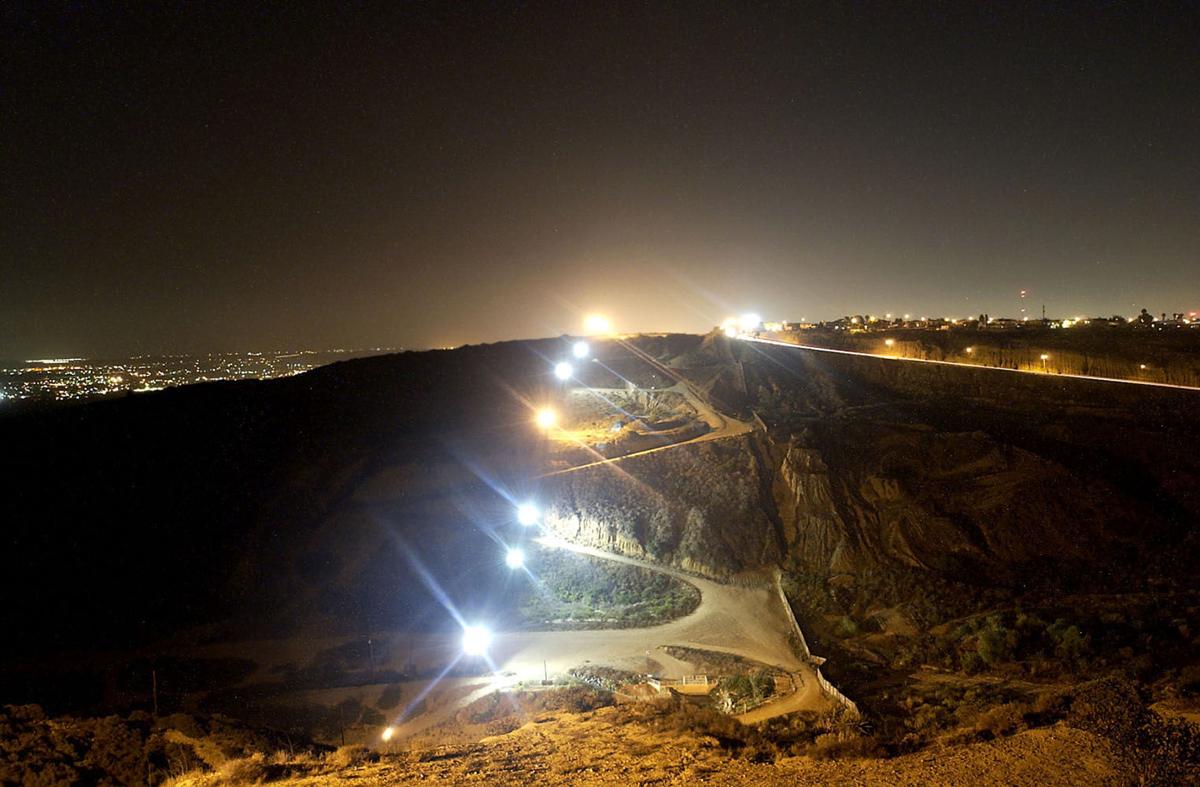
2006: Despite stadium lighting, rough terrain made Smuggler’s Gulch tough to patrol. The government decided to fill the 230-foot-deep canyon with dirt procured by leveling nearly mesas.
Beyond the Wall: Costly answer in California altering the landscape.
Jul 11, 2016
SAN DIEGO — Once a canyon created over thousands of years, Smuggler’s Gulch is now a massive earthen berm with two border fences and a road on top — the result of landscape alterations that cost taxpayers millions of dollars.
The federal government lopped off the tops of two mesas in 2008 and filled what was a 230-foot chasm with enough dirt to pack 72,000 dump trucks.
Smuggler’s Gulch, two miles east of the Pacific Ocean at the southernmost tip of San Diego County, is an extreme example of the challenges involved in fencing the entire U.S.-Mexico border.
Federal officials wanted the gulch filled to enhance the security of the border and the safety of U.S. personnel.
The department expedited the project through the Real ID Act, which Congress passed in 2005. The law allows the federal government to suspend all laws impeding the construction of border barriers in the name of national security.
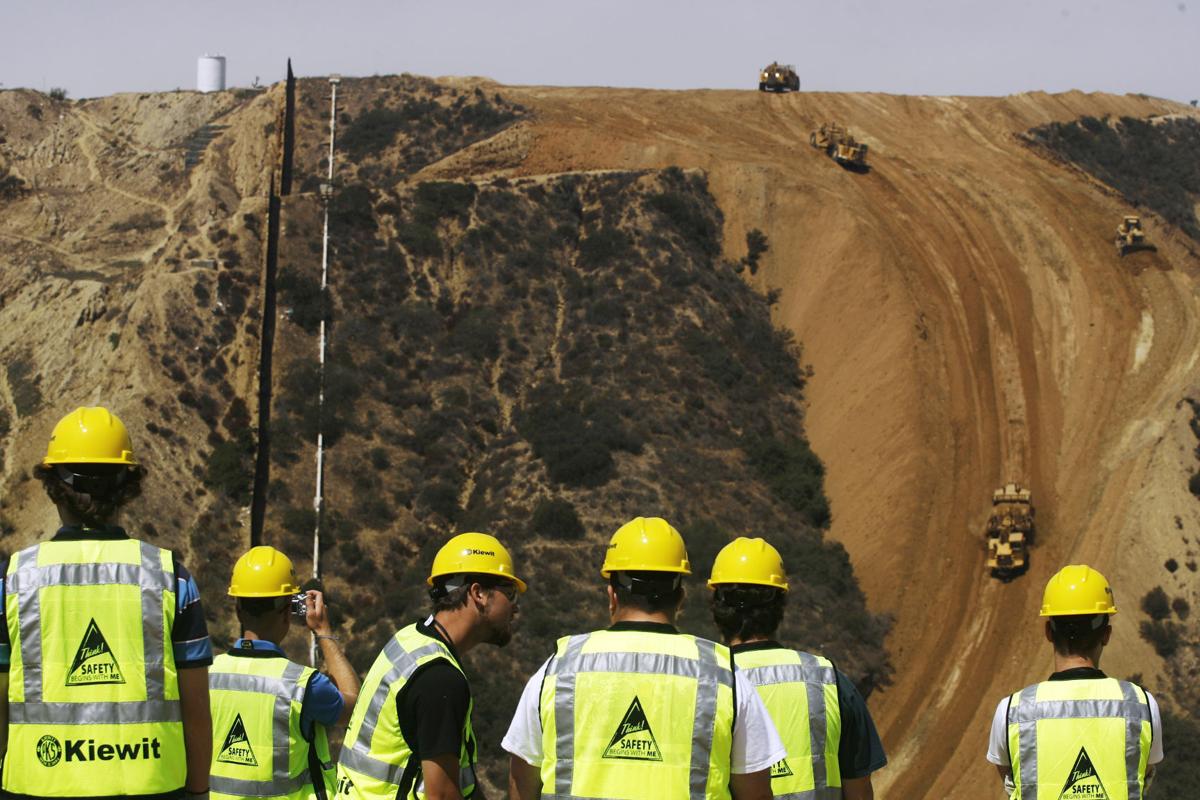
2008: After 12 years of planning, environmental reviews and legal challenges, workers began filling Smuggler’s Gulch to make way for a border fence.
In other words, when the federal government builds fences and other barriers along the border, it does not have to follow the Endangered Species Act, the Clean Water Act, the National Environmental Policy Act or the Migratory Bird Treaty Act, among others.
Directives to build border barriers often come from politicians who are not familiar with the border’s craggy canyons and meandering lines, nor with its natural heritage and ecology.
The Border Patrol, which carries out the directives, struggles to prevent illegal activity on the border while working with public land managers trying to protect natural habitat.
The agency also has funded projects to mitigate damage caused by the fence in California and other border states.
In Arizona, Organ Pipe Cactus National is restoring 230 miles of roads. Also, San Bernardino National Wildlife Refuge built a fish barrier to keep non-native species from entering the refuge and threatening native populations.
Many of the headline-generating environmental projects on the border have been in California, but the issues are similar all along the line. Fencing added in the last decade has been devastating to wildlife migration, to the natural flow of water after a storm, and to plant life along the border, environmental advocates say. There has been flooding, soil erosion and increased roadkill from night lighting and vehicle traffic, says the Sky Island Alliance, a Tucson-based conservation group.
Affected wildlife include ocelots and jaguars, migratory birds and bats, black bears, desert bighorn sheep, white-nose coati — all dependent on the ability to move back and forth across the borderlands.
“Barriers can block passage for animals in search of food, water or mates, for migration, or in response to drought and fire,” says Jessica A. Moreno, conservation, outreach and development manager for the Sky Island Alliance. “This infrastructure also pushes human activity to the last remaining open areas — rugged and wild habitat and wilderness that are now seeing more human impacts from border activities such as lighting, roads, trash and noise.”
The Yaqui chub fish, for example, is endangered and has little habitat left. Why does that matter to humans? Because the chub eats mosquitoes that bring viruses into the United States.
“We are all connected in one way or another,” says Bill Radke, manager of the San Bernardino Wildlife Refuge. “To not see that, to live with dire consequences of that, it’s not something that we should be headed for.”
Before Smuggler’s Gulch was filled in, the San Diego Audubon Society tried to stop the project with a lawsuit that predicted disastrous effects on the fragile Tijuana Estuary, the largest coastal wetland in Southern California.
Storm runoff from Mexico runs north through Smuggler’s Gulch and ends up in the estuary — and eventually in the Pacific Ocean.
The estuary is considered an essential breeding, feeding and nesting ground and key stopover point for more than 370 species of migratory and native birds, including six endangered species. But the lawsuit was tossed out of federal court because of the Real ID Act.
“It was really spectacular with beautiful geology,” says Jim Peugh, conservation manager for the San Diego Audubon Society. “Everyone expected they would screw it up — and they did.”
Border infrastructure is one more impact on the estuary, along with agriculture, the military and a huge population boom in Tijuana, now home to an estimated 2.5 million people.
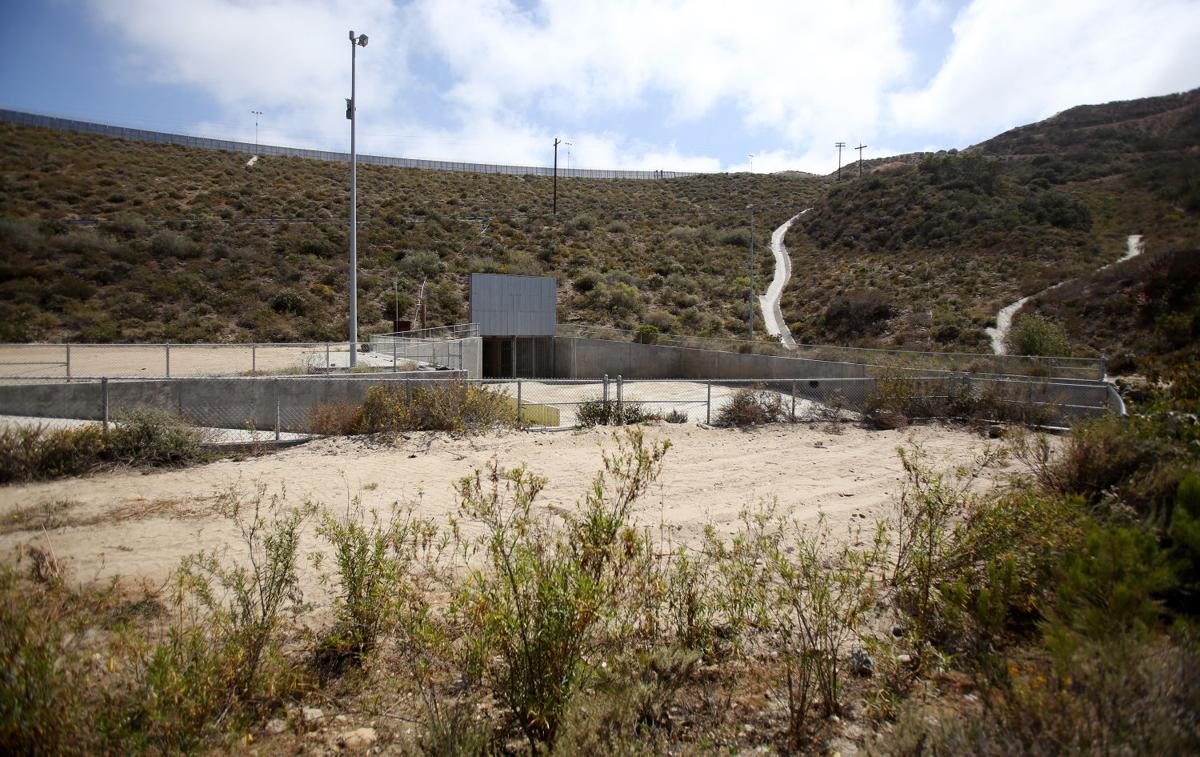
A culvert built between 2008 and 2010 in Smuggler’s Gulch carries water from Tijuana, Mexico, under the U.S.-Mexico border fence.
Carol Kimzey’s ranch is across the street from Smuggler’s Gulch. A decade ago, she told the Star she was skeptical about plans to fill the canyon. She worried that flooding at her home would get worse.
But her skepticism is, for the most part, gone. She no longer sees vehicles picking people up at night or people running through. She no longer hears car chases like the one that left a vehicle upside down in her front yard, the men inside jumping out and fleeing.
+8
Carol Kimzey
Carol Kimzey, ranch owner.
Mamta Popat / Arizona Daily Star
“There used to be hordes of 28 to 30 people, it sounded like an earthquake,” she says. “Now, I can’t remember the last time I’ve seen one.”
She gets wistful remembering her drives up to the top of the canyon, where she’d park and take in a view that included both her ranch and Mexico.
“I do miss that,” she says.
Her neighbor, James “Butch” Martin Jr., liked the old Smuggler’s Gulch. The 54-year-old retiree says he never minded the border crossers who passed through. Most were just looking for work and many found it at nearby ranches, he says.
He worries that the earthen berm could become unstable with heavy rains.
When that thing blows, it’s going to take us all out,” he says.
Water that once ran through the canyon is now redirected through a man-made culvert. That pushes runoff, including trash and sediment, faster and farther into the fragile Tijuana River Estuary, says University of California-San Diego professor Oscar Romo, who runs the binational nonprofit conservation group Alter Terra.
“It took 2 to 4 million years for nature to create this basin,” Romo says as he walks alongside the culvert. “Now all of that is gone.”
+8
Oscar Romo
Oscar Romo, professor in urban studies and planning at the University of California at San Diego.
Mamta Popat / Arizona Daily Star
As the only remaining estuary in Southern California, the Tijuana Estuary’s value is incalculable, he says.
“We treasure it. However, we are trashing it with these pieces of infrastructure that are not helping, that are not well-designed, that are generating heavy impacts on the natural resources of this area.”
Customs and Border Protection spent $58 million to fill in Smuggler’s Gulch, plus build 3.5 miles of secondary fencing, roads and lighting in the San Diego Sector. The sector includes 60 miles of border and more than three quarters of it — 46 miles — has some type of fencing.
A decade ago, 60 percent of the sector was fenced. Border Patrol officials believed at the time that certain parts of the sector, like the Otay Mountain Wilderness, did not need a fence because of their harsh terrain.
“There’s no reason to disrupt the land when the land itself is a physical barrier,” Richard Kite, then spokesman for the Border Patrol’s San Diego Sector, told the Star in 2006.
But three years later, the Department of Homeland Security completed a barrier in the Otay Mountain Wilderness Area — 3.6 miles of primary fencing and more than five miles of access road.
The rugged terrain required grading and leveling a federally designated wilderness area. That meant cutting down Tecate cypress trees and scraping off deep root systems of ground cover that held topsoil and moisture in place, says Jill Holslin, a Tijuana resident who maintains a blog about the borderlands called ”At the Edges.”
“The problem out there now is dryness and the absence of native plants,” Holslin says. When it rains, “there’s nothing to hold the soil in place. There’s also been an invasion of a parasitic plant that is taking advantage of conditions there, sapping whatever moisture there is in the soil.”
The best move to prevent more damage is to overturn Section 102 of Real ID Act, Holslin says.
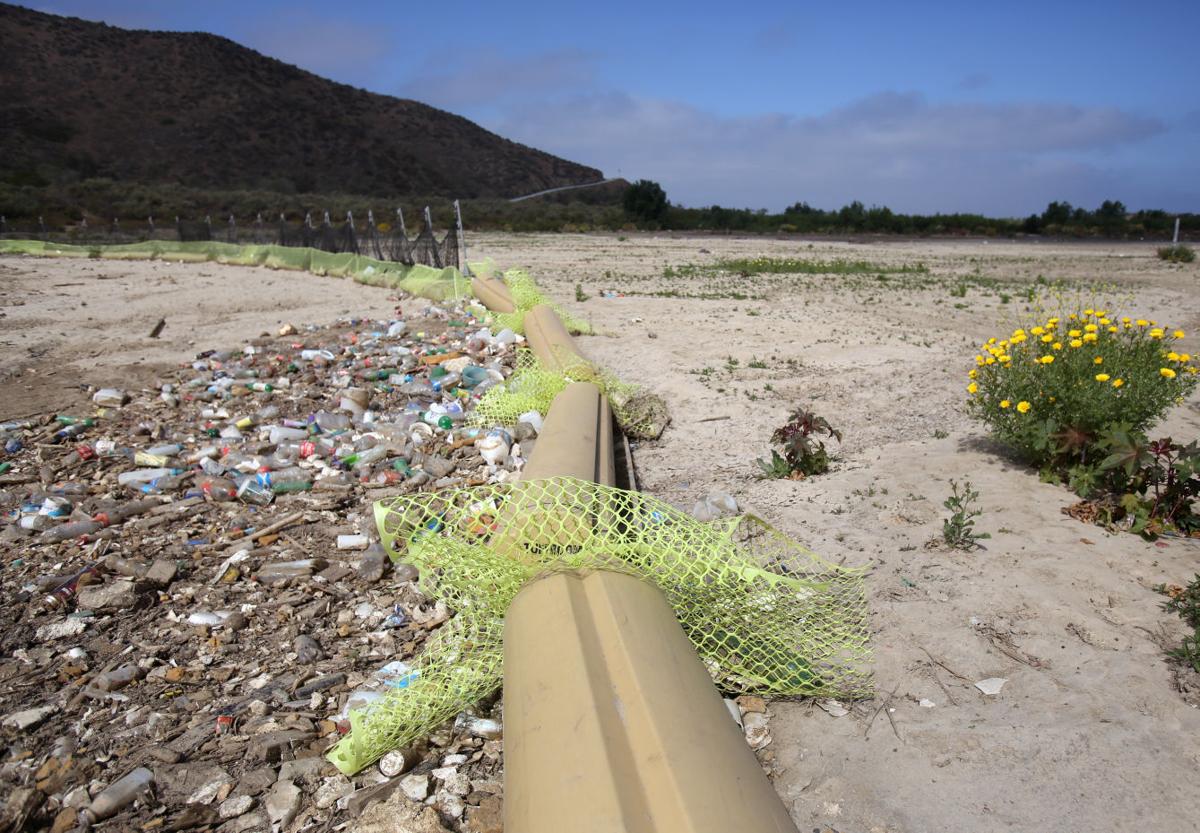
A sediment basin built in 2005 catches debris and trash coming downhill from Tijuana, Mexico. With an increase in development in Tijuana, more trash flows downward when it rains.
It has been three years since the government has used the act to grant waivers of federal laws in the name of border security, but it still has the power to do so, says Dinah Bear, former chief lawyer for the Council on Environmental Quality under four different U.S. presidents and now a Tucson resident. Lawsuits challenging the constitutionality of Real ID’s waivers so far have failed.
“They’ve taken away the mechanism for the public to fight back,” Holslin says. Area conservation groups like the Audubon Society and Wildcoast are the ones that understand the topography, she says. “You have to have their professional input in these processes and you’ve literally taken their voice away.”
But the voice of people who live on the border and the safety of those who protect it should count, too, says Dan Russell, 73, a retired firefighter from San Diego.
The border is “wide open, it’s not secure,” Russell says during one of his regular visits to the border community of Campo, California. “The Trump wall is a good example of a secure border. What we have now isn’t stopping people. Seven years ago they crawled underneath it, they jumped Border Patrol Agent Robert Rosas and shot him in the neck and killed him. Just four miles east of here.”
Beyond the Wall: At look a Smuggler's Gulch
https://tucson.com/special-section/beyond-the...07c90.html
As he drives along a road between the double fencing in the U.S. Border Patrol’s San Diego Sector, agent James Nielsen points to grates in the fence that let water through. It’s a complicated setup, letting water drain without creating tunnels smugglers can use.
Illegal tunnels have been found here, he says, motioning toward a building on the Mexican side where the floor was removed and turned into an elevator to a sophisticated cross-border tunnel that included a rail system and lights.
The sector has almost 2,400 agents, up 42 percent from a decade ago.
Apprehensions of people trying to slip across the border have dropped during that same time, by nearly 80 percent. Eight months into this fiscal year, there have been nearly 21,000 such apprehensions. Ten years ago the number topped 100,000 per year.
At the same time, seizures of harder drugs like cocaine and heroin have gone up, creating concerns about more sinister criminal activity.
Some San Diego and Imperial Beach residents refer to the border barrier near them as a “triple fence” because of chain link property fencing in some areas in front of the double line of fencing. Having those extra fences gives the Border Patrol more time, Nielsen says. He says the more deterrents and obstacles at the border, the less likely someone will make it across.
“When they built the fence, they said that one of the environmental benefits was that the Border Patrol would no longer need the spider web of roads they used to look for border crossers,” says Peugh of the San Diego Audubon Society.
“They said they would get rid of them and restore the damaged habitat. I looked at an aerial photo of the river valley and estuary recently. I do not have a pre-triple-fence photo to compare, but there is still a spider web of roads.”
One of the agencies working to mitigate damage to habitat in the area is the state of California, which operates the Tijuana River National Estuary and Research Park. The state works with the Border Patrol to minimize roads and disruption of the natural ecosystem, says Chris Peregrin, an environmental scientist who is manager of the park.
The state’s mission is to restore the natural functions of the area. Yet, in an example of how their missions differ, the Border Patrol doesn’t want plants near the border growing too high because people can hide in them.
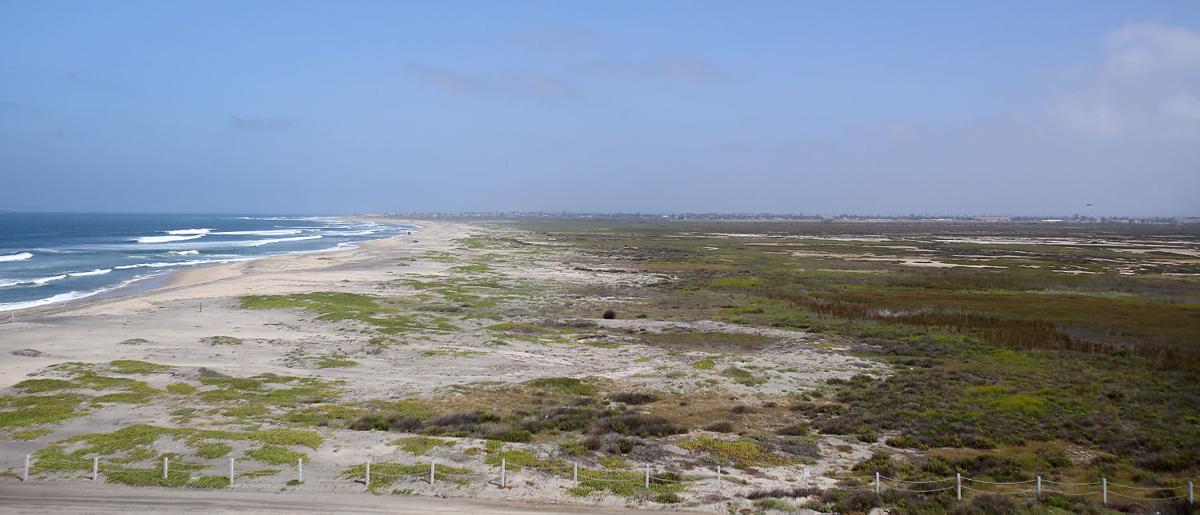
The Tijuana Estuary, covering 1,700 square miles, is one of the most significant coastal wetlands in Southern California. It runs right into the Pacific Ocean at Imperial Beach in San Diego.
Environmental advocates point to numerous spots along the border where fencing has gone up without regard to existing laws. The San Pedro River and the San Pedro Riparian National Conservation Area in Arizona, just west of Naco, is a biologically diverse area and home to one of the last free-flowing rivers in the Southwest.
“It’s a beautiful riparian area that’s the lifeblood of the desert,” U.S. Border Patrol sector spokesman John Lawson says.
The river, which flows south to north across the border, is less than a mile wide. Vehicle barriers across it let large wildlife and water flow freely, although the river is dry part of the year.
As he walks in the riverbed along the border, Lawson points out the paw prints of a black bear that indicate the animal has come north from Mexico. Moments later, a deer crosses the Normandy-style criss-crossed posts of the vehicle barrier and is later seen further north where the San Pedro is flowing.
Barriers like these are the only place where large wildlife can regularly pass along a 47-mile stretch of border running east from the Huachuca Mountains. The rest of that stretch of border has pedestrian fencing that’s impenetrable to large wildlife, though some areas have gates the Border Patrol opens during monsoon season.
Just east of the river is a compound that belongs to Glenn Spencer, president and founder of the nongovernment American Border Patrol. Spencer is a retired systems engineer whose group has developed technology, including sensors in the ground, to detect illegal activity.
Before the U.S. Department of Homeland Security put up 18-foot fencing behind his home, Spencer says it was like the “Wild West.” There was so much illegal activity, including cars driven across his property by drug smugglers, that he was afraid to walk his dogs .
“Now it’s like a gated community,” he says.
Spencer dismisses environmental arguments against the high fence behind his home.
“Rabbits run through it all the time. The fence design allows certain critters to get through,” he says. “Javelina and deer are limited to the riparian area around the river, but look at Google Earth. They have plenty of habitat in Mexico.”
The Sierra Club and others tried to stop six miles of 18-foot-high bollard-style pedestrian fencing from going up in the San Pedro area, but they failed because of the Real ID Act.
Since then, wildlife such as mule deer and javelina have been unable to access habitat in Mexico, says Dan Millis, borderlands coordinator for the Sierra Club’s Grand Canyon chapter in Tucson. Millis refers to the fencing as a wall, since wildlife cannot pass through.
“Every day wildlife is coming up to the wall and turning around. I saw a doe and two fawns at San Pedro. They walked up to the wall and took a look — they looked for a way to cross and came back,” Millis says. “They need to migrate and need to get up and down in elevation to survive. The border is blocking their ability to do that and is a threat to their survival.”
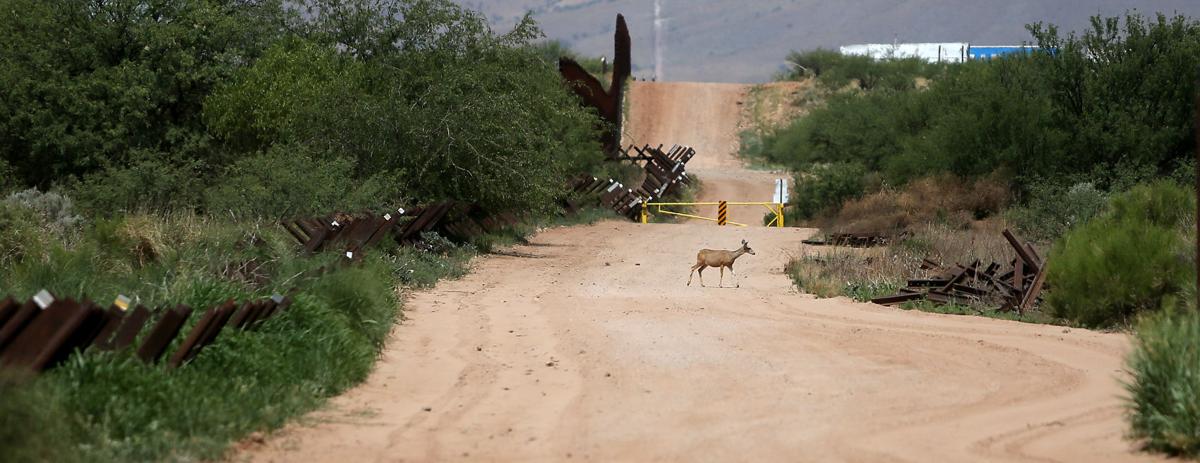
A deer passes through from Mexico into the United States through the vehicle barrier or "Normandy" type fencing in the San Pedro River National Conservation Area inside the Coronado National Memorial park in Arizona. The vehicle barriers are used so that wildlife can cross freely.
Border barriers create problems for desert bighorn sheep and pygmy owls, University of Arizona researchers found in a 2009 study published in the journal Conservation Biology. The fence divided habitats and put bighorn at risk for inbreeding in a smaller gene pool, the study says.
“It takes a long time for wildlife to adapt to this kind of thing, and by the time they adapt it could be too late,” Millis says.
Intermittent fencing does not prevent humans from illegally crossing the border, but it does restrict the movement of puma and coati in Arizona, says a study conducted by British researchers and published in the journal Plos One in 2014.
That same study found that every 1,000 unauthorized immigrants crossing an international boundary generates 110 pounds of litter, 11 campfires and disturbs habitat of plants and animals.
Of concern to many wildlife advocates is an adult male jaguar dubbed “El Jefe” that was photographed by a remote camera 118 times over 34 months in the Santa Rita Mountains southeast of Tucson.
Even after the federally funded research by the UA and the U.S. Geological Survey ended last June, El Jefe — the only known wild jaguar in the United States — continued to show up in photos regularly through mid-October of last year.
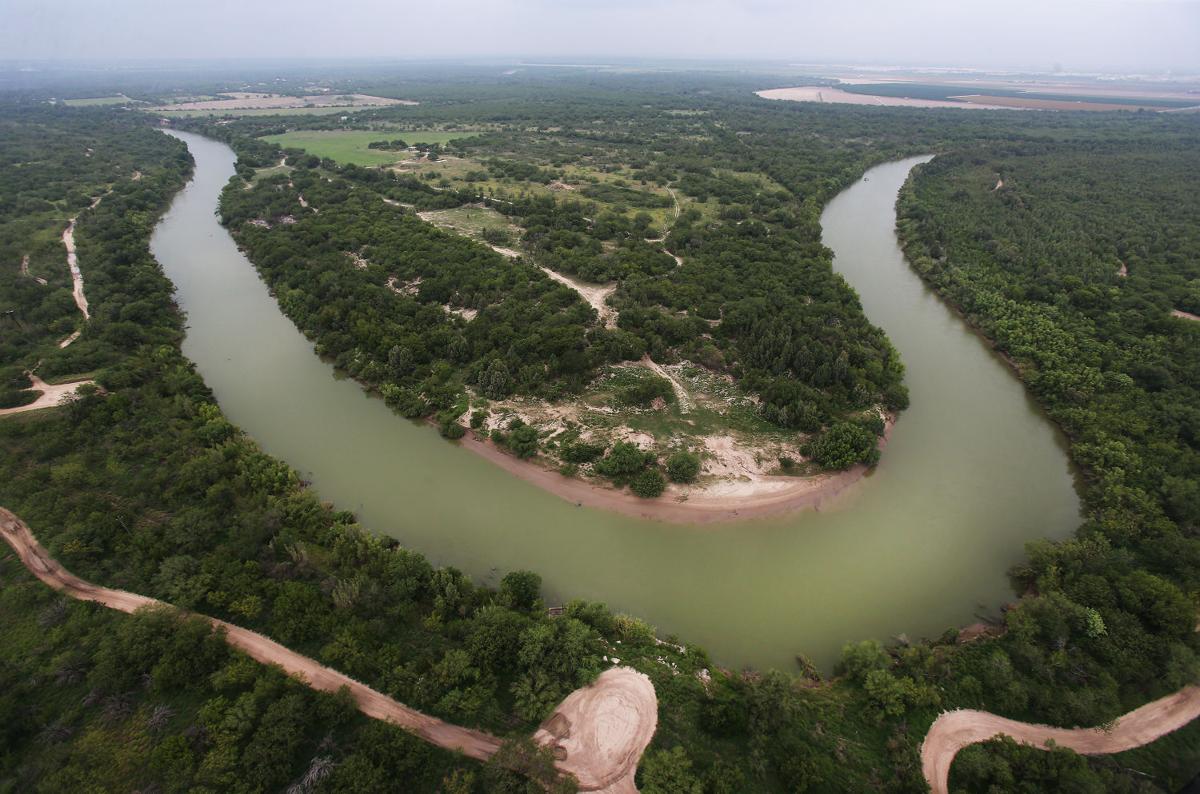
“The river does what the fence does,” says Manuel Padilla, who used to run the Border Patrol’s Tucson Sector but now is in Texas guarding the winding Rio Grande, which forms part of the U.S. border with Mexico. Today, many of those detained at the Texas border are families and unaccompanied minors not trying to escape detection.
Beyond The Wall: Unfenced borderland is mostly in Texas
McALLEN, Texas — When people talk about building a border fence, often they’re talking about Texas.
Nearly half of the border between Mexico and California, Arizona and New Mexico already has some sort of barrier.
But Texas, which claims 1,245 of 2,000 miles on the nation’s southern border, has only about 100 miles of fence.
The Rio Grande, narrow in West Texas but swelling to an average of 200 feet across in the Rio Grande Valley area, has been a natural divider.
A decade after the Secure Fence Act required the Department of Homeland Security to build up to 700 miles of border fence, what’s been built so far is not only what made sense tactically, but what was easiest to put up, says Scott Nicol, who leads the Sierra Club’s Borderlands campaign out of McAllen.
Nicol walks through the Old Hidalgo Pumphouse, one of nine locations of the Rio Grande Valley’s World Birding Center, less than half a mile from the border. A sign promises a pedestrian walking trail into the National Wildlife Refuge next door, yet the path ends at an enormous metal gate flanked by a fence made from 18-foot-high steel beams.
“They built this here because it’s federal land and they didn’t have to fight anybody,” he says.
Most of the land along the border in the Western states is owned by the federal government, something known as the Roosevelt Easement. This 60-foot buffer does not exist in Texas, where private landowners must give up their property for a fence to be built.
To put up the 100 miles of fence that exist today required 400 landowner condemnations and led to several long and costly lawsuits.
A further challenge: A treaty between the U.S. and Mexico prohibits building anything that interferes with the flow of the river or that worsens flooding for either country. As a result, in most places the fence stands on top of the levee, half a mile or more from the river.
In the Rio Grande Valley, the southernmost tip of Texas anchored by the cities of McAllen and Brownsville, the fence doesn’t separate countries. It cleaves farmlands, splits backyards and divides neighborhoods.
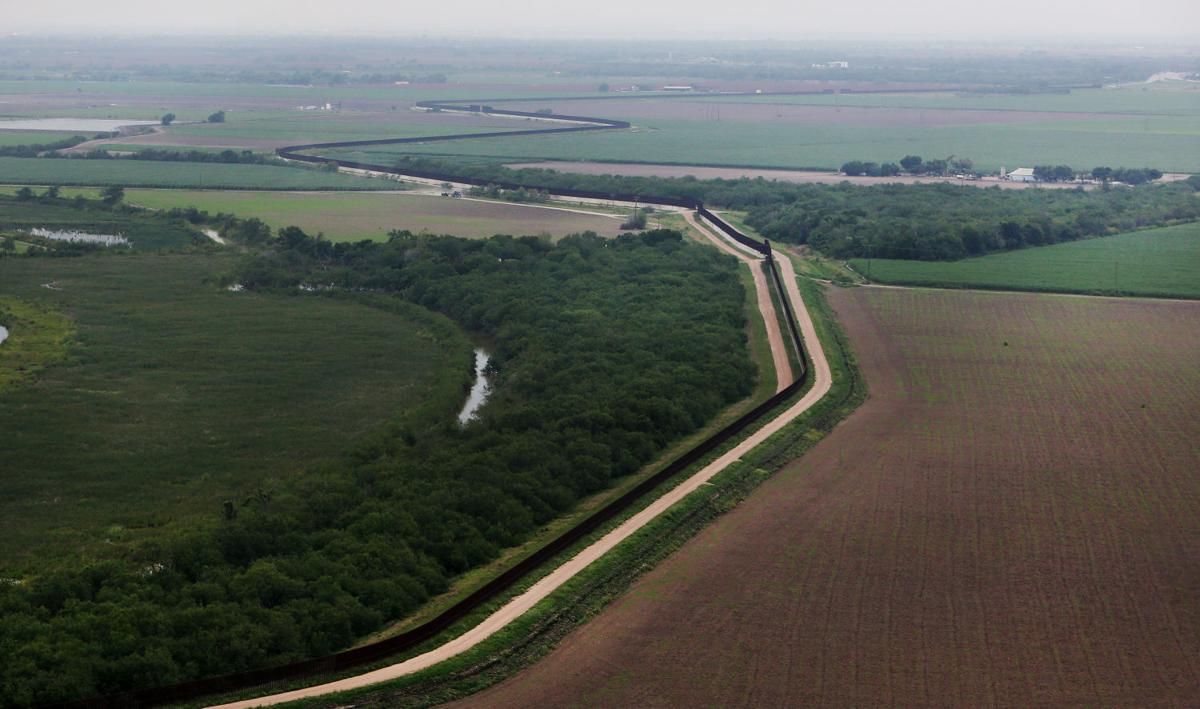
Putting up 100 miles of border fence in Texas, like this stretch in Brownsville, meant 400 landowner condemnations and several costly lawsuits. More fencing is not a Border Patrol priority in certain areas, according to the chief of the Rio Grande Valley Sector.
Researchers speculate the jaguar might have gone to Mexico to breed, signifying the need for continued wildlife corridors for larger animals along the border.
From above, the path of the Rio Grande looks like a cursive sentence written during an earthquake. The river flows and folds, winds and rewinds, curls and curves.
Flying over the Border Patrol’s Rio Grande Valley Sector, the challenges for enforcement are clear. The argument for the existing fence can be won or lost depending on which of the 18 sections of fencing that dot the area you focus on.
Even with air support from a helicopter flown by agents with Air and Marine Operations, with Border Patrol agents on foot and on ATVs, once smugglers make it past the river, they can disappear in the dense vegetation.
In some areas they run into a concrete levee wall topped by an 18-foot fence. The easiest way to get across is to find a road that goes through the barrier. This funneling is part of the tactical benefit of the fence, officials say.
In other areas, the fence can be easily climbed. And in some places, the fence just stops and there is no barrier at all.
But more fencing is not a priority, says Manuel Padilla, chief of the Border Patrol’s Rio Grande Valley Sector. That’s because the river does what the fence does.
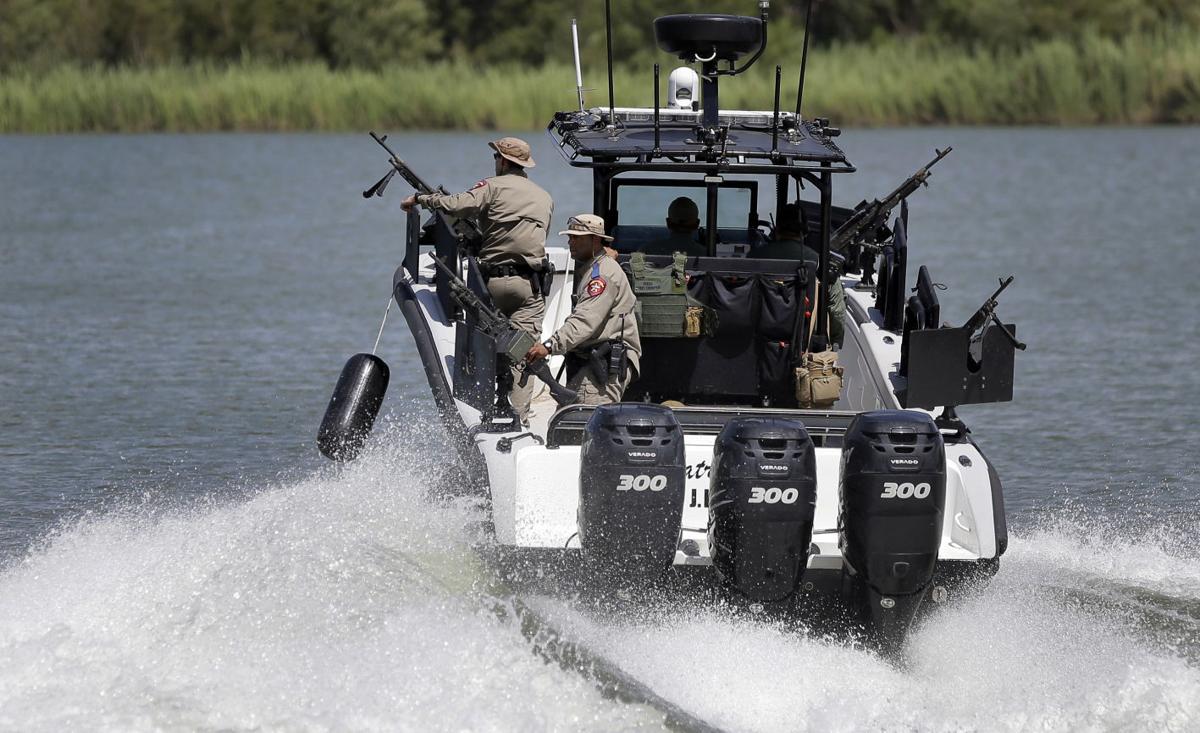
State troopers patrol the Rio Grande in Mission, Texas, near McAllen. Once smugglers make it past the river, they can disappear in dense vegetation.
“If you have detection technology where you are monitoring the river, it doesn’t have to be a fence. And then you have river patrols,” he says.
Padilla, who was chief of the Border Patrol’s Tucson Sector before taking command in Texas earlier this year, says fencing works in population centers, pointing to Nogales as a place where it was critical to curtailing traffic.
“That was our busiest area for several years, just that small stretch of border. You have a fence, you have a road and then you have technology and you have the people to complement that enforcement strategy,” he says.
But Texas and Arizona are not the same, and the strategies for securing their borders should not be the same, he says.
“The terrain here is totally different. The technologies we use in Arizona may or may not — in most cases, do not — work to the level that it works over there,” he says. “Here you have very dense vegetation, the cloud cover, the humidity. It calls for a totally different type of technology.”
When it comes to border security, Padilla differentiates between his agency’s primary missions: anti-terrorism efforts, cross-border crime and illegal immigration.
Keeping tabs on those who would harm America by exploiting the border between the ports of entry is the top priority, he says. And that job depends as much on personnel, technology and infrastructure as it does on intelligence efforts.
Beyond that, he says, sealing the border is not an attainable goal.
“You are always going to have cross-border crime, period. You’re always going to have migration, you’re always going to have to deal with the demand for narcotics and the supply of narcotics. We’re not in the business of guarantees but we are in the business of mitigating risk to a level where people feel safe along the border communities.”
The Rio Grande Valley Sector has come to prominence the last few years for the soaring number of immigrants being detained.
Last year, the sector had 147,000 apprehensions, more than double Tucson’s 63,000.
It all has to be put in perspective, Padilla says.
Ten years ago, the Tucson Sector saw 392,000 apprehensions. Go back to 2000 and it topped 600,000. So even the high-water mark for the Rio Grande Valley Sector, which so far is fiscal 2014, was far below how things used to be.
And the immigrants being detained are far different, a large percentage being unaccompanied minors and families.
While the vast majority of illegal immigrants here used to come from Mexico, now most come from Central America — El Salvador, Honduras and Guatemala.
“That population was not trying to evade apprehension, they were actually turning themselves in, so that presented us with an immigration/humanitarian crisis that has no law enforcement solution,” Padilla says — that's because they're seeking asylum so they can stay here legally.
And from his view, it doesn’t need one.
“When we’re talking about unaccompanied alien children and family units,” he says, “the threat to our officers or to the community that is presented by that population does not keep me awake at night at all.”
Conny Cruz, seven months pregnant, paid $3,000 to cross the river with her two children. It would have been more, she says, if she had paid a smuggler to take them from El Salvador to the border. But she decided to cross Mexico on her own.
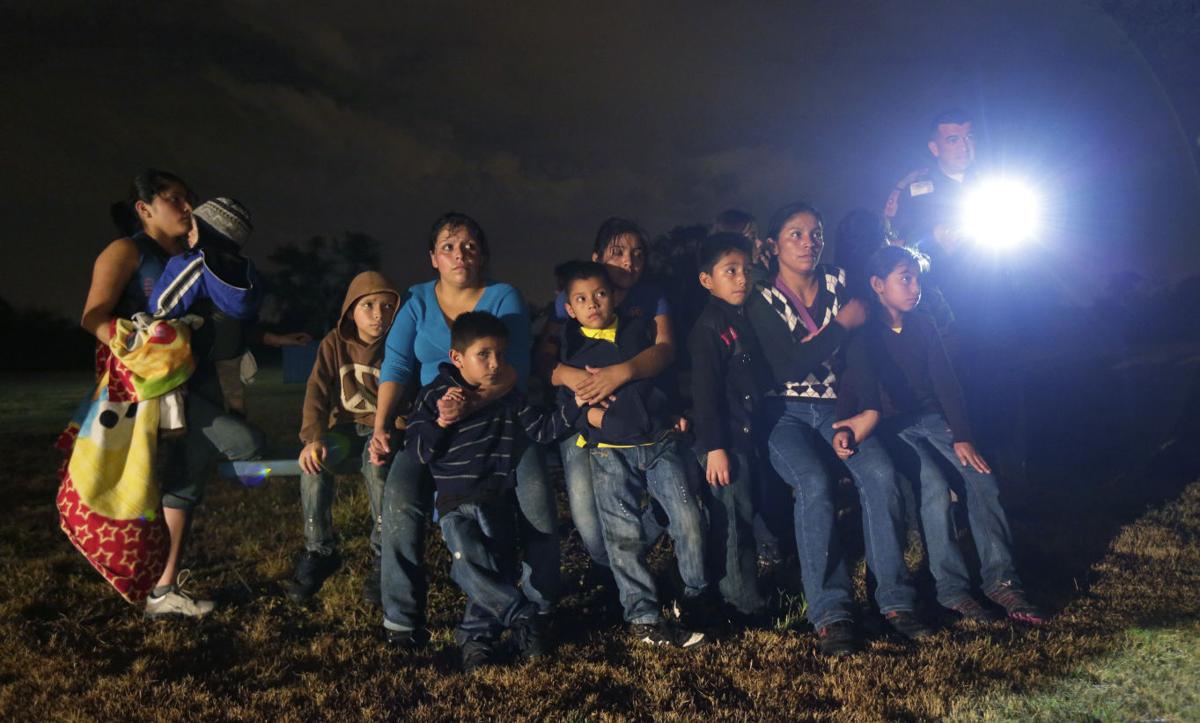
2014: At the height of the Central American influx into the United States, these immigrants from Honduras and El Salvador were stopped in Granjeno, Texas.
It was never her dream to come to the United States, just a way to flee a nightmare.
She was watching a neighborhood soccer game with her kids when a young boy, maybe a few years older than her 9-year-old son, walked up to a player and shot him dead.
That was the last straw.
Her aunt, who lives in Fort Worth, sent her money and paid a smuggler to help them cross. They spent three days in a warehouse before they hopped on an inflatable raft for the short trip across the Rio Grande. They walked for an hour before the Border Patrol detained them.
She and her children were released and she has to meet with immigration officials once she’s in Fort Worth.
Cruz doesn’t know whether she’ll get to stay or not, but her priorities were more immediate.
“I have to pay my aunt what she spent and get my children back in school.”
Drive south down Calle Milpa Verde in Brownsville and eventually you drive through the fence.
Like many spots in the Rio Grande Valley where the rust-colored steel barrier seems to pop up arbitrarily, it is a strange site. On one side you have Texas. On the other … more Texas.
Pamela Taylor was born in England, came to the United States in 1946 and became a naturalized citizen in 1951.
“I’m a gung-ho Texan,” she says.
Shortly after they arrived she and her husband bought two acres of land, about 1,000 feet from the river, and paid it off at $10 a month. It was the time of the bracero program, she says, and whole families would come over from Mexico to work, then go back. There were few problems.
But times have changed, she says. It’s different. And, for her, the fence only made things worse.
The barrier funnels border crossers to openings where Border Patrol can more easily intercept them. Taylor’s house is in that funnel. Since the fence went up, she and her family have found marijuana under the bougainvillea bushes, watched high-speed car chases and played unwitting host.
“I had an illegal sitting in that rocking chair there,” she says. “This guy had come in, he had used my bathroom facilities and washed, shaved and everything, he was sitting there, watching the Border Patrol go by.”
The man left when asked but he gave her a fright.
Even though she doesn’t approve of those who enter the country illegally, she keeps coolers by her mailbox stocked with water and sodas, free for the taking by Border Patrol agents and border crossers alike.
“Everyone thinks the fence is along the river. No, it’s on the shoulder of the highway, it’s behind people’s houses,” says Michelle Moncivaiz, Taylor’s daughter. “People who farm and worked all their lives, they open their front door and that’s what they’ve got to look at.”
While Taylor has been on her property for almost 70 years, Eloisa Tamez can trace her family’s ownership back to 18th-century Spanish land grants.
Her property was bisected by the border fence.
“The politicians like to call it a fence, but it’s not a fence. I have a fence around my property and it looks different. That’s a wall,” she says.
As the government moved to build the fence, it was disheartening how unwilling officials were to listen to property owners, they say.
The government bureaucracy, led by then-DHS Secretary Michael Chertoff, didn’t seem to understand the different relationship between people in the valley and their land, Tamez says.
“My father farmed, my grandfather farmed. They carved out a life for us that way,” she says. “The land and the water, it’s so valuable.”
Tamez sued the government, one of several court actions in Texas against the border fence. Even though she knew she would eventually lose the battle, she took pride in the fight.
“I wanted to make sure that when Chertoff stepped into his last day of work, Dec. 31, 2008, that wall wouldn’t be up. And it wasn’t,” she says.
They had a tamal-making party to celebrate. But although the secretary left office, the fence still came.
Now, if Tamez wants to access the part of her land on the other side of the fence, she either has to go about a quarter mile east, down a road to get to the levee and then back to her property, or more than half a mile west to an opening in the fence.
“Farmers or ranchers in Kansas or Nebraska, can they go through all their land without being not only stopped by a barrier but by the Border Patrol? Why are we not equally protected?”
While Tamez speaks for many landowners affected by the fence, some feel it’s a necessary sacrifice.
“I feel more secure and sleep better at night,” says Jesse Reyes, whose home is only a few feet from the fence that cuts across his property. He’s lived there for more than 40 years and his extended family occupies the houses next to his.
Most of their property extends behind the fence, where his father used to farm. There’s a horseshoe lake back there where they fish and take out a boat.
Behind the fence is where he walks his dog.
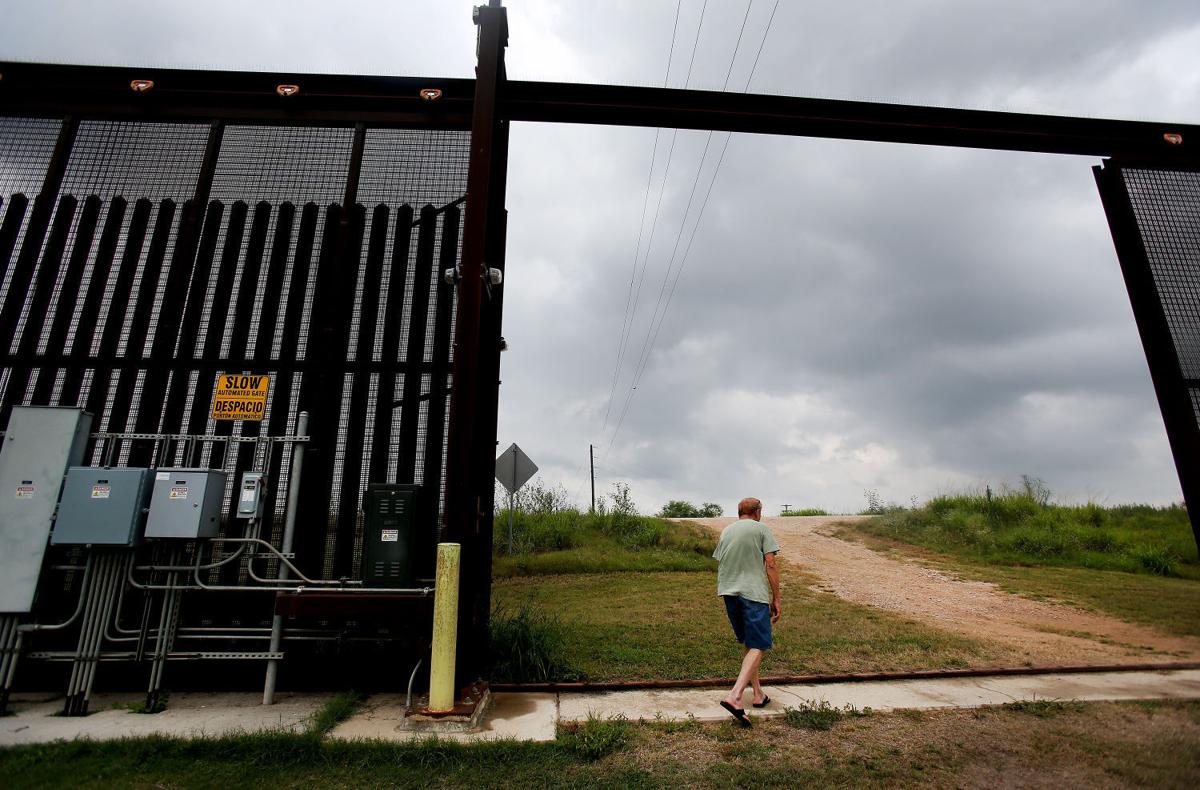
Using a pass code, Brownsville landowner Jesse Reyes opens a government-owned gate, giving him access to the rest of his property.
Every morning, Reyes punches numbers into a keypad a few feet from his backyard. A government-owned gate opens, giving him access to the rest of his property. Most days it opens slowly, unless there’s been a storm and the fence got hit by lightning, then the code stops working for a while.
He waves to the Border Patrol agents who drive along the road that runs by the fence. They chat sometimes. On one walk he found 60 pounds of marijuana.
Even those who oppose the border fence will tell you it has changed things considerably here.
“Before you would see Border Patrol chasing people down the street. It was the Wild West,” says Mark Clark, artist and owner of Galería 409, who watched his fair share of chases from his home in downtown Brownsville.
But it made for a livelier city, he says, and he had a nicer view.
“I bought this place because it had beautiful river views from the balconies and I scarcely go out there anymore,” he says.
To Clark, the fence is an affront to Mexico and international relations. So are the expensive bridge tolls, long lines at the ports of entry and the U.S. drug war, which has turned a formerly peaceful town like Matamoros across the river into a narco battlefield, he says.
Many people whose lives were impacted by the fence here — those who had to give up part of their property or who ended up living south of the barrier — believe it does not stop illegal traffic.
“It was a political movement to fill the pockets of corporations, but what does it do? I know we get all sorts of figures all the time, but we also know that a lot of people continue to pass through,” says Tamez, who was involved in one of the court actions to stop the fence.
There are a few arguments for the fence, she says, but they’re hollow.
“It helps fight terrorism, they say, but no one responsible for 9/11 came through this border,” she says. “It keeps out undocumented people, but if governments that have all the resources in the world cannot stop illegal immigration, how’s a wall supposed to do it? Then it’s drugs. If at any time the people who sell those drugs cannot cross that wall, they’ll blow it down.”
If anything, the fence gives people a false sense of security, says Scott Nicol of the Sierra Club.
“The river doesn’t stop anybody. The wall doesn’t stop anybody,” he says.
While there was a lot of opposition when the fence was proposed and as it went up, people have learned to live with it, Nicol says.
“It’s like if somebody builds a dump next to your house and after a while you get used to the smell. You still hate it but you just don’t pay it a lot of attention,” he says. “It generally gets written off as one more wasteful federal government boondoggle.”
But the idea of more fencing — or Donald Trump’s wall — is not a popular option in South Texas.
“Just enforce the laws we have now and it will be a lot cheaper,” says Rod Hickman, a truck driver from Killeen, Texas who describes himself as, “a Christian, a Texan and an American. In that order.”
“If people can’t work here then they won’t come here,” he says. “Let’s try the easy things first.”
Many border residents support immigration reform, especially a guest worker program that lets immigrants work legally and then return home. The same goes for holding the countries that immigrants come from responsible for the violence and poverty that force their citizens to leave.
“It makes much more sense to address the root causes, the reasons people want to come, and regulate that traffic,” Nicol says. “As opposed to coming up with this idea that you’re going to stop it. It’s just not realistic.”
https://tucson.com/special-section/beyond-the...8c6c3.html
 (0)
(0) (0)
(0)